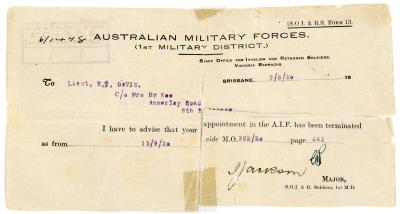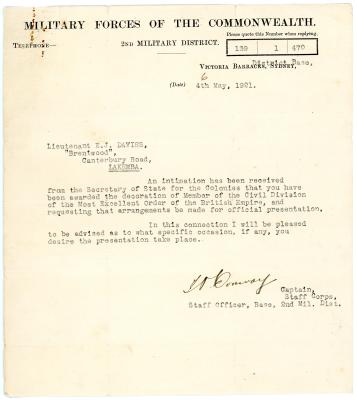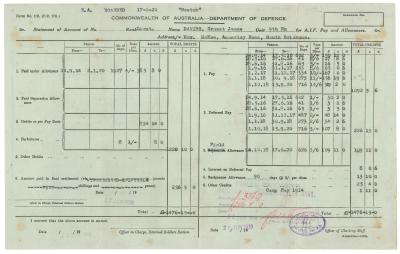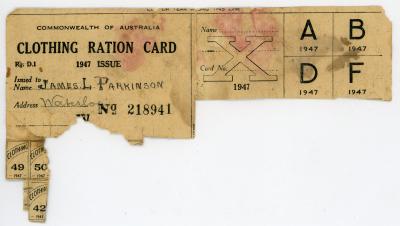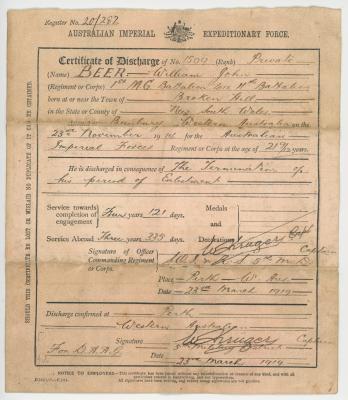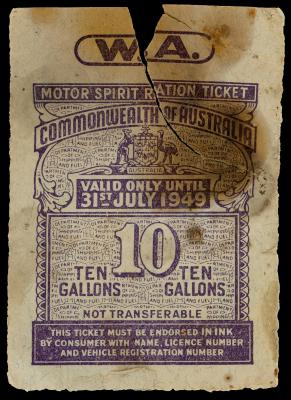1967 ANZAC Commemorative Medallion and Certificate of Pte. William John BEER 1509
1967A commemorative medallion cast in bronze. The obverse of the medallion depicts Simpson and his donkey carrying a wounded soldier to safety. It is bordered on the lower half by a laurel wreath above the word ANZAC. A crown sits atop the medallion and is visible from both sides The reverse shows a map in relief of Australia and New Zealand superimposed by the Southern Cross. The lower half is bordered by New Zealand fern leaves. The name and initials of the recipient is engraved on the reverse. The medallion is issued in a leather presentation box with purple cloth lining inside the lid and purple velvet on the stand where the medallion sits.
The Medallion is accompanied by an A5 size printed certificate. The proforma information is printed in blue ink on a cream parchment type paper. At the centre top of the paper is printed the Australian Coat of Arms. The reverse of the certificate is blank. The paper has been folded into eighths.
In March 1967 the Prime Minister, the Rt. Hon. Harold Holt, announced that a commemorative medallion and badge was to be issued to surviving members of the Australian Defence Force who served on the Gallipoli Peninsula, or in direct support of the operations from close off shore, at any time during the period from the first Anzac Day in April 1915 to the date of final evacuation in January 1916. The medallion was issued to commemorate the 50th anniversary of the ANZAC Gallipoli landings in 1965.
Details
Details
On the medallion obverse “1915 / ANZAC” and reverse “W. J. BEER”.
On the certificate “In / commemoration of the heroic deeds / of the men of / ANZAC / at / Gallipoli in 1915 / and / in recognition of the great debt / owed by all Australians. / With the Compliments of / the Government of / the Commonwealth of Australia.”
An image of Private John Simpson of the Army Ambulance Corps, aiding a wounded soldier on his donkey at Gallipoli, is featured on the front of the medal. Simpson became renowned for his work as a stretcher-bearer and as the man with the donkey at the Gallipoli battlefield who saved many lives. He landed at Gallipoli on 25 April 1915 and was killed less than four weeks later. Simpson used donkeys (landed for water carrying) to transport wounded men from the front line fighting to the beach on Anzac Cove, working in extreme conditions of heavy fighting. He died in action on 19 May from machine gun fire, as he was guiding down two wounded men. Simpson's actions demonstrated the qualities of courage and mateship that have become associated with the term 'Anzac'.
Open in Google Maps
Nearest geotagged records:
- Invalid Cup (0km away)
- Peter Loney Letter (0km away)
- Ellis SILAS Water Colour Painting (0km away)
- Engraved Japanese Water Bottle belonging to Robert George Staunton RENNIE WX7493 (0km away)
- Enlistment Poster (0km away)
- W. D. & H. O. Wills Lace Flag Cigarette Cards (0km away)
- First world War Picture Postcard (0km away)
- Photograph of the Japanese surrender to Australia on 13 September 1945. (0km away)
- Engraved Tin given to Major Arthur Robinson HOME WX11151 (0km away)
- Martini-Henry action (0km away)
Nearby places: View all geotagged records »
Princess Royal Fortress Military Museum
Princess Royal Fortress Military Museum
Other items by Australian Government
- Australian Military Forces Termination Notice for Lieut. Ernest James DAVIES
- Letter to Lieut. Ernest James DAVIES from the “Military Forces of the Commonwealth” regarding MBE presentation
- Commonwealth of Australia Department of Defence Statement of Account for Lieut. Ernest James DAVIES
- Second World War Royal Australian Engineers 13th Field Coy AIF Shoulder Colour Patch (single)
- Commonwealth of Australia Clothing Ration Card Issued to James L. PARKINSON
- 1967 ANZAC Commemorative Lapel Badge and Certificate of Pte. William John BEER 1509
- First World War Discharge Paper of Pte. William John BEER 1509
- Commonwealth of Australia WA Motor Spirit Ration Ticket
Other items from Princess Royal Fortress Military Museum
- Swiss Silver Pocket Watch Lid
- The Anzac Book sent to Alice Jean BOYLAN
- The WA Digger Book from Roebourne RSL
- Print of The Late Lieut-General Sir Talbot HOBBS
- First World War Medal Trio of Sergeant Frederick Ernest BRUCE 243
- Trench Art Pendant of Sergeant Frederick Ernest BRUCE 243
- First World War Medal Trio of Pte. William John BEER 1509
- Pair of Standard Issue Spurs of Sergeant Frederick Ernest BRUCE 243
- First World War Princess Mary Gift Tin
- First World War Improvised Identity Discs Sergeant Frederick Ernest BRUCE 243
- 1908 Belgium 25 Centimes Pierced Coin Sergeant Frederick Ernest BRUCE 243
- Framed Marriage Photograph Sergeant Frederick Ernest BRUCE and Elsie Eva BRUCE (nee HARRIS)
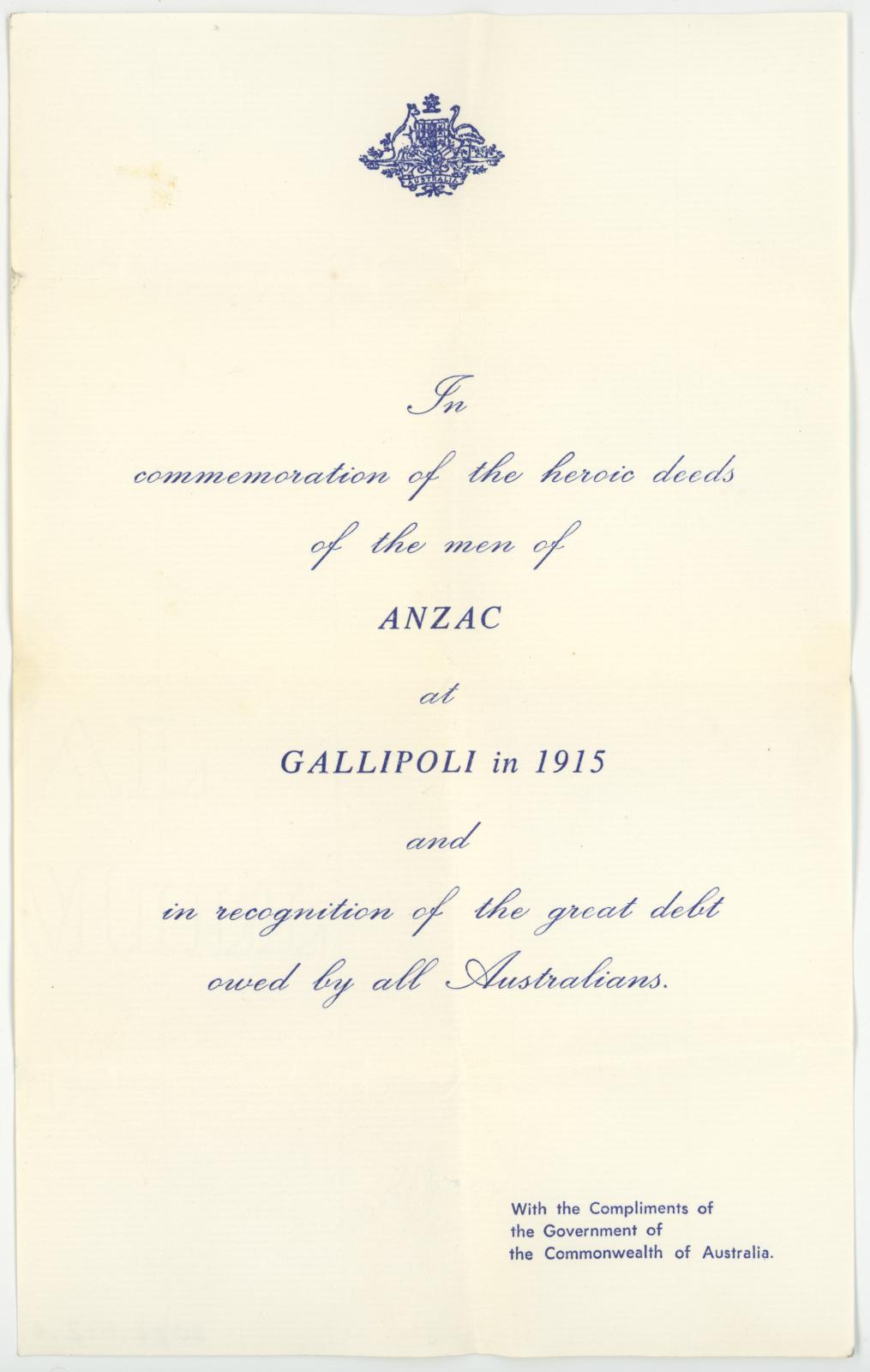
Scan this QR code to open this page on your phone ->

